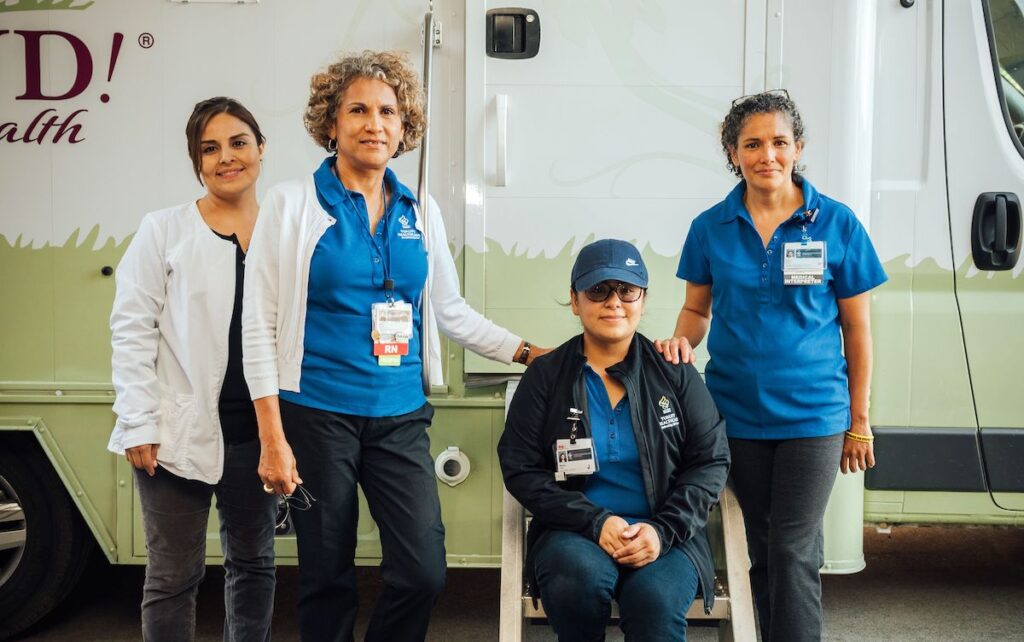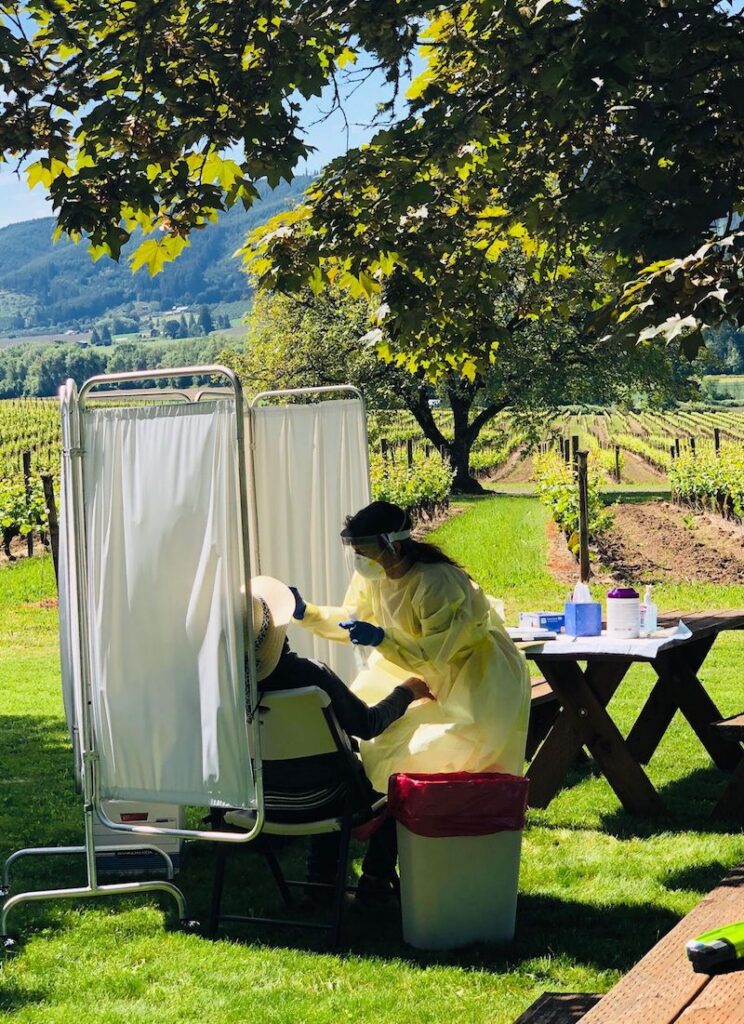Raise a glass to these dedicated workers who nurture the vines and the people around them.
By Danielle Centoni
While swirling an elegant Oregon wine in your glass, your thoughts might turn to the winemaker who crafted it and the multitude of decisions that turned clusters of grapes into something so delicious. But you probably don’t think about the multitude of people who ensure that those clusters of grapes make it to harvest. You usually won’t find their names on the labels, but as Oregon’s wine industry veterans will tell you, they’re absolutely essential to each and every bottle.

They’re people like Juan Ordaz, a 76-year-old native of Michoacán, Mexico, who for the past 28 years has been working through wind, rain, heat, and cold to tend the vines at Chehalem Winery.
“Juan is exceptionally dedicated to his job,” says Harry Peterson-Nedry, Chehalem’s founder. “He has conviction, and a commitment to hard work and to making certain that the job that needs to get done gets done.”
As the vineyard supervisor, Ordaz oversees the entire crew of workers— most of whom are his family—as they spend months pruning, training, and thinning, not to mention replacing posts, planting, and, of course, harvesting. “They’re a very talented group of people,” says Peterson-Nedry. “They can tell a crop load just by visually looking at plants—and they’re exceptionally precise. They can pick out diseases and problems before others see them.”
Another part of Ordaz’s job is managing personalities and keeping his crew happy. “He has to be the leader, and that’s many times more difficult,” Peterson-Nedry says. “I feel very lucky to have the luxury of not having to worry about where we’re going to find the skilled labor for the vineyard. We know Juan and his crew are going to be there. When you take that off the plate, it makes winemaking a lot easier.”
Ordaz and his team are just a few of Oregon’s estimated 90,000 Latino agricultural workers, many of whom work in the 35,000 acres of patchwork vineyards across the state. And the number of vine-planted acres increases every year.

But as a seasonal and often migrant workforce, many agricultural workers and their families have no health insurance and face a multitude of barriers to accessing even basic health care. Back in the early 1990s, a small group of Willamette Valley winemakers, including pioneering vineyard owner Nancy Ponzi, recognized this challenge and mobilized to help establish a unique partnership with OHSU Health Hillsboro Medical Center (formerly Tuality Healthcare), a nonprofit community health-care organization in Hillsboro. Their efforts resulted in ¡Salud! Services, which addresses health-care needs for migrant workers in the vineyards.
“This industry is family-oriented, and the vineyard workers are valued as being part of the family,” says Leda Garside, who has served as the clinical services manager for ¡Salud! from the very start. “That’s how it began.”

Garside, a registered nurse with a BSN degree as well as an MBA, was tapped to engineer the program, which has no parallel anywhere else in the country. “When I was recruited, I was asked if I could figure out what needed to be done: What are the needs? Where are the gaps?” she says. There was no blueprint to follow, but she used her professional and personal experience to blaze a path. “Coming from an occupational health background really helped me. And I’m a Latina, so I’m able to bring my culture and my language.”
In the more than 20 years since its inception, the ¡Salud! program has grown from reaching 140 people to several thousand each year. “The approach we have is a holistic approach to health care,” says Garside. “It’s not just, We see you, bye, have a nice day. You have to complete the circle. It’s based on the nursing theory of ‘following up.’”
That’s why in addition to operating mobile units for wellness clinics and health screenings, ¡Salud! providers also help patients navigate the system and find the care they need year-round, even going with them to appointments and making home visits. Garside says the goal is to make ¡Salud!’s services as comprehensive as possible, even partnering with other agencies to meet needs that go beyond their scope, such as dental work and eye exams.
Oregon’s wine industry leaders know that great wine requires dedicated hands at every step, and they support their extended vineyard family as a matter of principle. ¡Salud! is funded entirely by philanthropic donations and proceeds from the annual ¡Salud! wine auction. Almost 50 wineries donate their top Pinot noir lots for the auction, while others donate wine for the dinner. “The wine industry is extremely generous to our program and so supportive,” says Garside. “They’re the ones who provide the funds for us to function.”
One such winery is the pioneering Adelsheim Vineyard, whose first plantings took root in 1972. Adelsheim has been partners with ¡Salud! for a long time. “The program is such an important part of the Oregon wine region—and the culture,” says Rob Alstrin, Adelsheim CEO.
It’s a culture that values community, collaboration, and mentorship—an ethos evident at Adelsheim itself. There, employees like Vineyard Manager Kelli Gregory are given the space to grow, experiment, and push themselves—and the industry—even further.
“I started in the summer of 2012 as a vineyard technician,” says Gregory, who had just earned her master of agriculture degree, with an emphasis in viticulture, from Oregon State University when Adelsheim recruited her. “The cool thing about viticulture is it’s an amazing overlap of farming, science, horticulture, geology, and landscape design. And it’s always evolving.”
At only 30 years old, Gregory was promoted to the job of vineyard manager, a critical role that means making strategic decisions about soil, fertilization, pest control, pruning, planting, and harvest for the winery’s eight estate vineyards, as well as those owned by Adelsheim’s grower partners. But even talented as Gregory is, she depends on her own team, a crew of 10 that can swell to 60 during the busiest parts of the season, to help relay eagle-eye observations in the vineyards.
“When the vines are waking up, we’ll be in the field, looking at where bud break is and recording and documenting,” says Vineyard Technician Danielle Zarro, who works side-by-side with Gregory. “During harvest, we’re out doing quality control and orchestrating logistics.”
Zarro, a fellow Oregon State alumna, emphasizes that Gregory isn’t just focused on the plants, though. “She really cares about her crew,” says Zarro, giving voice to a widely held sentiment around these parts: among the most important ingredients for the success of Oregon wine is the sense of family that flourishes alongside the vines.
It’s that respect and commitment to the human aspect of the industry that brings dedicated people like Juan Ordaz, who will return for his 29th vintage in the Chehalem Mountains this year, back again and again. It’s what drives people like Leda Garside to keep expanding the reach and services of ¡Salud! And it’s what inspires and deepens the bonds of the next generation, people like Kelli Gregory and Danielle Zarro, to continue to work hand-in-hand to push Oregon wine to new heights.


